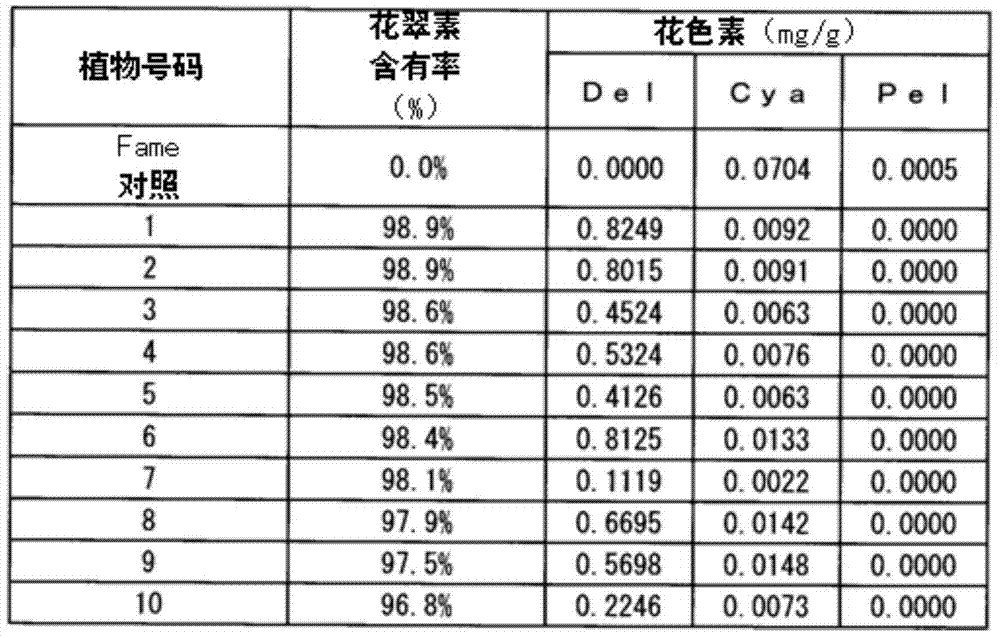Novel campanula flavonoid 3',5'-hydroxylase gene and use of same
An amino acid and base sequence technology, applied in genetic engineering, oxidoreductases, enzymes, etc., can solve unpredictable and complex problems
- Summary
- Abstract
- Description
- Claims
- Application Information
AI Technical Summary
Problems solved by technology
Method used
Image
Examples
Embodiment 1
[0066] [Example 1: Separate isolation of Bellflower F3'5'H cDNA]
[0067] Based on the translated sequence of Campanula medium F3'5'HcDNA (accession number D14590) registered in the DNA database GenBank, two primers CamF1 (5'-GTGAAGCCACCATGTCTATAG-3', sequence number 3) and CamR1 (5' - GCATTTGCCTAGACAGTGTAAG-3', SEQ ID NO: 4). RNA was extracted from petals of commercially available bellflower buds using RNeasy Mini Plant Kit (QIAGEN), and 1st strand DNA was synthesized using RT-PCR kit. Using this 1st strand DNA as a template, PCR was performed using the primers described above. The resulting DNA fragment was cloned into pCR-TOPO II. Inside, the nucleotide sequence of clone #4 (pSPB2561) was determined by analysis with a DNA sequencer (SEQ ID NO: 1). The F3'5'H registered as accession number D14590 consists of 523 residues compared to the F3'5'H encoded by clone #4 consisting of 521 residues relative to the F3'5'H registered as D14590 Showing 96% sequence identity.
reference example 1
[0068] [Reference Example 1: Introduction of pSPB130 into the Chinese rose variety "Lengshui" (constitutive expression of pansy F3'5'H gene and torenia 5AT gene)]
[0069] The binary vector pSPB130 (constitutively expressing the F3'5'H gene of pansy and the anthocyanin 5-acyltransferase gene of torenia in plants) described in Patent Document 3 was introduced into Agrobacterium ( Agrobacterium tumefaciens) Agl0. This transformed Agrobacterium was introduced into the lavender rose variety "Lengshui" by the method described in Patent Document 3, and 164 transformants were obtained. When the anthocyanin pigments in petals were analyzed, delphinidin accumulation was confirmed in 51 of 164 transformants, and the delphinidin content rate was the highest at 76.1% (36.6% on average).
[0070] Analysis values of representative transformants are shown in Table 1 below.
[0071] 【Table 1】
[0072]
[0073] Del: delphinidin, Cya: anthocyanin, Pel: anthocyanin
[0074] Delphinidin ...
Embodiment 2
[0075] [Example 2: Introduction of pSPB2564 into the rose variety "Lengshui" (expression from the F3'5'H gene of Bellflower under the control of the E12 35S promoter)]
[0076] The expression cassette in which the bellflower F3'5'H gene cDNA obtained in Example 1 was inserted between the El2 35S promoter and the nopaline synthase terminator (nos terminator) described in Patent Document 3 was inserted into a binary vector pBinPLUS (van Engelen et al. Transgenic Research 4, 288-290, 1995), and the resulting plasmid was designated as pSPB2564. pSPB2564 was introduced into Agrobacterium tumefaciens Agl0. Using this transformed Agrobacterium, the lavender rose variety "Lengshui" was transformed by the method described in Patent Document 3, and 55 transformants were obtained. When the anthocyanin pigments in the petals were analyzed, delphinidin accumulation was confirmed in 48 of the 55 transformants, and the delphinidin content was the highest at 97.3% (average 61.22%).
[0077]...
PUM
 Login to View More
Login to View More Abstract
Description
Claims
Application Information
 Login to View More
Login to View More - R&D
- Intellectual Property
- Life Sciences
- Materials
- Tech Scout
- Unparalleled Data Quality
- Higher Quality Content
- 60% Fewer Hallucinations
Browse by: Latest US Patents, China's latest patents, Technical Efficacy Thesaurus, Application Domain, Technology Topic, Popular Technical Reports.
© 2025 PatSnap. All rights reserved.Legal|Privacy policy|Modern Slavery Act Transparency Statement|Sitemap|About US| Contact US: help@patsnap.com



